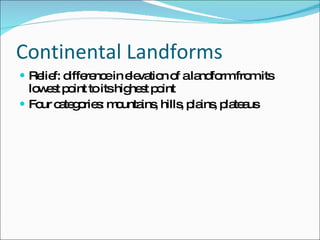Chapter Two, Section 2
- 1. Chapter 2, Section 2
- 2. The Reality of the H 2 the IS 0! No freshwater, no saltwater = no life Water supports plants, animals Helps distribute heat on earth
- 3. Oceans and Seas Salt water covers 71 % of planet (60 % of Northern Hemisphere, 81% of Southern Hemisphere) Atlantic, PACIFIC, Indian, Arctic
- 4. Ocean Motion Salt water circulates through 3 basic motions: Currents - act like rivers flowing through ocean Waves - ridges produced by winds Tides - rises and falls of the ocean created by gravitational pull of moon or the sun Oceans help distribute heat on the planet; winds blow over ocean and are either heated or cooled by water, then blow over land, which moderate temperature of air over the land
- 6. Hydrologic cycle: what happens? Water evaporates into the atmosphere from oceans, bodies of water, and plants (the water exists in atmosphere as vapor) Vapor cools, condenses, and falls to earth as precipitation, rain, or snow Water soaks into the ground, evaporates to the atmosphere, or flows into rivers to be recycled
- 7. Lakes, Rivers, and Streams Lakes = 95% of all earth’s fresh water supply Largest --Lake Baikal in Russia (totaling 18% of all freshwater on earth) Freshwater lakes are result of glacial action thousands of years ago Saltwater lakes result from changes in earth’s surface that cut off outlets to the sea - form when creeks and rivers carry salts, but no outlet Largest salt lake: Caspian sea --Western Asia
- 8. Un poco mas… Drainage basin: an area drained by a major river and its tributaries Ground water: water held in the pores of rocks Water table: level at which the rock is saturated - can rise or fall depending on amount of water pumped out of ground
- 9. Activity: IDENTIFY THIS and THAT Now, turn your book to page 34 and 35. Mr. Philen is going to show you a variety of pictures of landforms, identify them…
- 18. What landforms exist in Senegal? In Africa? How could we draw a landform map for Senegal? What elements would we include?
- 19. Continental Landforms Relief: difference in elevation of a landform from its lowest point to its highest point Four categories: mountains, hills, plains, plateaus
- 20. Continental Landforms you need to know Volcano -mountain Strait -valley Island -glacier Cape/peninsula -cataract Bay -canyon Swamp -cliff Flood/plain -plateau Marsh -mesa Oasis -prairie Steppe
- 21. Oceanic Landforms There are landforms similar to the land on the sea floor Continental shelf - earth’s surface from edge of a continent to the deep part of the ocean Ocean floor contains ridges, valleys, canyons, plains Longest: Mid-Atlantic Ridge Islands can form from volcanic action
- 22. Questions for thought 1) How do the winds and the ocean distribute heat on the earth’s surface? 2) Why is water such a valuable renewable resource? 3) Describe what happens with the hydrologic cycle.






















